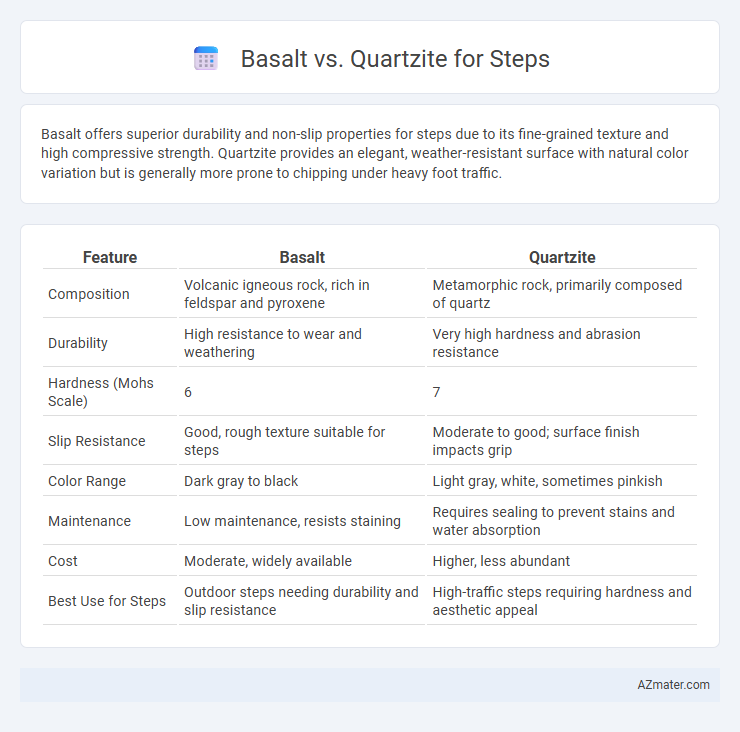Basalt offers superior durability and non-slip properties for steps due to its fine-grained texture and high compressive strength. Quartzite provides an elegant, weather-resistant surface with natural color variation but is generally more prone to chipping under heavy foot traffic.
Table of Comparison
| Feature | Basalt | Quartzite |
|---|---|---|
| Composition | Volcanic igneous rock, rich in feldspar and pyroxene | Metamorphic rock, primarily composed of quartz |
| Durability | High resistance to wear and weathering | Very high hardness and abrasion resistance |
| Hardness (Mohs Scale) | 6 | 7 |
| Slip Resistance | Good, rough texture suitable for steps | Moderate to good; surface finish impacts grip |
| Color Range | Dark gray to black | Light gray, white, sometimes pinkish |
| Maintenance | Low maintenance, resists staining | Requires sealing to prevent stains and water absorption |
| Cost | Moderate, widely available | Higher, less abundant |
| Best Use for Steps | Outdoor steps needing durability and slip resistance | High-traffic steps requiring hardness and aesthetic appeal |
Introduction to Basalt and Quartzite as Step Materials
Basalt is a dense, volcanic igneous rock known for its durability and resistance to weathering, making it ideal for outdoor steps that endure heavy foot traffic and environmental stress. Quartzite, a metamorphic rock formed from sandstone, offers exceptional hardness and a natural, glassy luster that combines aesthetic appeal with strong structural integrity for steps. Both materials provide excellent slip resistance and longevity, but basalt tends to have a more uniform dark color, while quartzite exhibits varied patterns and shades, influencing design preferences for stair applications.
Physical Properties: Durability and Hardness
Basalt exhibits exceptional durability due to its fine-grained structure and high compressive strength, making it highly resistant to weathering and wear in exterior steps. Quartzite stands out for its superior hardness, often exceeding 7 on the Mohs scale, which ensures long-lasting surface integrity against scratches and impacts. Both stones provide excellent slip resistance, but quartzite's crystalline composition offers enhanced resistance to chemical and physical degradation compared to basalt.
Aesthetic Appeal: Colors and Textures
Basalt offers a sleek, dark-gray to black palette with a fine-grained, uniform texture that provides a modern, minimalist aesthetic ideal for contemporary steps. Quartzite features a wider color range, including whites, grays, pinks, and blues, with varied swirling patterns and natural veining that create a dynamic and elegant appearance. The choice between basalt and quartzite for steps depends largely on desired visual impact, with basalt favoring understated sophistication and quartzite delivering vibrant, eye-catching character.
Slip Resistance and Safety
Basalt offers superior slip resistance compared to quartzite due to its naturally rough texture, making it a safer choice for steps in both wet and dry conditions. Quartzite, while durable and visually appealing, tends to have a smoother surface that can become slippery when wet, increasing the risk of slips and falls. Choosing basalt for steps enhances safety by providing better traction and reducing the likelihood of accidents in high-traffic or outdoor areas.
Weather and Climate Suitability
Basalt exhibits exceptional durability and resistance to freeze-thaw cycles, making it ideal for steps in regions with harsh winters and fluctuating temperatures. Quartzite's natural hardness and low porosity provide excellent resistance to weathering and UV exposure, suitable for steps in hot, dry climates. Both stones offer strong slip resistance, but basalt typically withstands moisture and temperature extremes better, ensuring long-term stability in varied climates.
Installation Process and Complexity
Basalt offers a dense, fine-grained structure that allows for straightforward cutting and shaping during step installation, making it slightly easier to work with compared to quartzite. Quartzite's high hardness and variable grain patterns require specialized cutting tools and more precise handling to prevent cracking, increasing installation complexity and time. Both materials need proper sealing after installation to enhance durability and resist weathering, but basalt's uniformity typically results in a smoother, more predictable installation process.
Maintenance Requirements
Basalt steps require minimal maintenance due to their dense, non-porous nature, which resists staining and weathering, making them ideal for outdoor use. Quartzite steps need regular sealing to protect against moisture penetration and potential surface etching, especially in high-traffic or exposed areas. Both materials demand periodic cleaning, but basalt's durability reduces the frequency and intensity of upkeep compared to quartzite.
Cost Comparison: Basalt vs Quartzite
Basalt steps generally cost less than quartzite due to its abundant availability and easier quarrying process, making it a budget-friendly option for landscaping projects. Quartzite steps command a higher price because of their superior hardness, durability, and aesthetic appeal, which require more intensive extraction and processing. Evaluating project budget constraints against desired longevity and visual impact helps determine the most cost-effective choice between basalt and quartzite.
Environmental Impact and Sustainability
Basalt steps provide a sustainable choice due to their abundant natural availability and minimal processing requirements, resulting in lower carbon emissions compared to quartzite. Quartzite involves more intensive mining and energy-consuming refinement, increasing its environmental footprint. Both stones offer durability, but basalt's environmental advantage makes it preferable for eco-conscious landscaping projects.
Choosing the Right Stone for Your Steps
Basalt offers high durability and a non-slip surface ideal for outdoor steps exposed to varying weather conditions, while quartzite provides a harder, more scratch-resistant finish with natural color variation suited for aesthetic appeal in both indoor and outdoor settings. Consider basalt if you prioritize longevity and low maintenance, especially in wet or icy climates, whereas quartzite is best chosen for its elegant look and resistance to wear in high-traffic areas. Selecting the right stone depends on balancing durability, texture, and environmental exposure to ensure safety and visual appeal for your steps.

Infographic: Basalt vs Quartzite for Step
 azmater.com
azmater.com